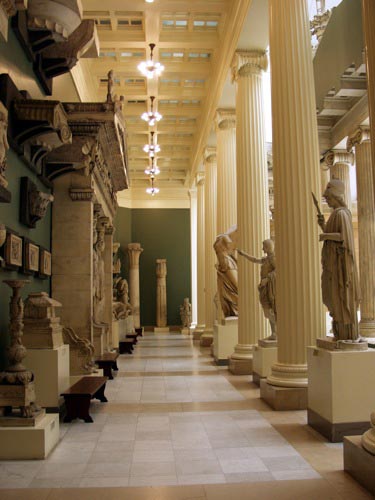
Courtesy Carnegie Museum of Art
Some of us have memories of piling into a yellow school bus with our fellow sixth-graders to go to the big city to visit an art museum. We had lots of fun with our buddies on those days, but the art probably had little to do with it.
Today, art museums are truly places of wonder — for sixth-graders and 60-year-old bank travelers. For the art connoisseurs, the oil paintings by the old masters are still there. But in addition, there are galleries showcasing photography with historic scenes from our neighborhoods and memories, decorative arts that make us want to go home and redo our living rooms, and temporary exhibits featuring once-in-a-lifetime viewing opportunities.
Today, the buildings themselves are architectural works of art, places of awe at first glance. Often surrounded by water, parks and trails, these museums offer their own breathtaking views.
Carnegie Museum of Art
Pittsburgh
One of four Carnegie museums in Pittsburgh, the Carnegie Museum of Art is recognized for its collection of American and European works from the 16th century to the present. Founded by Andrew Carnegie in 1895, it was the first museum of modern art in the United States.
“We are always looking for the ‘masters of tomorrow,’” said Jonathan Gaugler, media relations manager. “Early acquisitions of such artists such as James McNeill Whistler and Winslow Homer started this tradition.”
Also interesting are the collections of European and American decorative arts from the late 17th century to the present, architect-designed objects and the museum’s collection of film and video. The photography collection includes the exhibit “Teenie Harris, Photographer: An American Story,” one of the most detailed and intimate records of the black urban experience known today.
“Our Hall of Architecture contains the largest collection of plaster casts of architectural
masterpieces in America and one of the three largest in the world,” said Gaugler.
To complement this museum’s modern slant, 2013 brings “Inventing the Modern World: Decorative Arts at the World’s Fairs, 1851-1939.” This temporary exhibition explores the craftsmanship of decorative arts made for events such as the London Great Exhibition of the Works of Industry of All Nations in 1851 to the New York World’s Fair in 1939. Visitors will learn that during this period, those fairs were the most important vehicles to debut furniture, metalwork, glass, ceramics, textiles and jewelry.
www.cmoa.org
Crystal Bridges Museum
of American Art
Bentonville, Arkansas
Housed in 12 galleries in four buildings, the works of Colonial, 19th-century, modern and contemporary art are arranged chronologically to provide a journey through American history at the Crystal Bridges Museum of American Art. The American wonders include works from Richard Caton Woodville, Maria Oakey Dewing, Norman Rockwell and Andy Warhol.
The landscape surrounding the museum is as much a part of the experience as the artwork inside it. Visitors are treated to more than three miles of trails with poignant and whimsical sculptures, grand boulders, more than 500 dogwood trees, an evergreen forest, tulip trees, bubbling springs and massive flower gardens.
Groups will want to see “Focus: The Portrait,” an upcoming temporary exhibit featuring three early-20th-century portraits on loan from the National Gallery of Art. The artists — James McNeill Whistler, John Singer Sargent and George Bellows — are represented in Crystal Bridges’ collection but not through portraits.
Canopied by glass and natural wood, the museum’s restaurant, Eleven, is also a work of art. Favorites from the South and Midwest, influenced by local farmers and food artisans, are on the menu.
High Museum
Atlanta
The High Museum’s permanent collection guarantees visitors a journey through time and across continents, according to Kristen Heflin, manager of public relations.
“Our collections consist of more than 12,000 pieces and include 19th-century and 20th-century American and decorative art, European pieces, modern and contemporary art, photography, African art and folk art,” she said.
Located in the heart of midtown Atlanta, the museum has earned its share of bragging rights. The decorative arts and design collection is the most comprehensive survey of American decorative arts in the southeastern United States. In addition, the High is the only major museum in North America to have a full-time curator devoted to the field of folk and self-taught art. And the photography collection showcases some of this country’s most poignant moments in the African-American struggle for civil rights.
Heflin is especially excited about two 2013 exhibitions. The first, “Gogo: Nature Transformed,” is an exploration of the role the natural environment plays in shaping jewelry and home wares.
“Gogo Ferguson, the designer, lives on a barrier island off the Georgia coast, and she uses her surroundings as inspiration,” said Heflin.
“‘Frida and Diego,’ a tribute to perhaps Mexico’s most famous artists, Frida Kahlo and her husband, Diego Rivera, really showcases the political turmoil in Mexico. Quite simply, this is a really cool exhibition, and the High Museum will be the only U.S. venue that has it.” she said.
Heflin suggested enjoying a meal of regional favorites at the museum’s gourmet restaurant, Table 1280, after an afternoon at those exhibitions.









